Mercedes EQV vs Renault Trafic Bus – Differences & prices compared
Compare performance, boot space, consumption and price in one view.
Find out now: which car is the better choice for you – Mercedes EQV or Renault Trafic Bus?
The Mercedes EQV (Bus) comes with a Electric engine and Automatic transmission. In comparison, the Renault Trafic Bus (Bus) features a Diesel engine with Manuel or Automatic transmission.
When it comes to boot capacity, the Mercedes EQV offers 1410 L, while the Renault Trafic Bus provides – depending on how much space you need. If you’re looking for more power, decide whether the 204 HP of the Mercedes EQV or the 170 HP of the Renault Trafic Bus suits your needs better.
In terms of consumption, the values are 27.10 kWh per 100 km for the Mercedes EQV, and 6.80 L for the Renault Trafic Bus.
Price-wise, the Mercedes EQV starts at 51300 £, while the Renault Trafic Bus is available from 38200 £. Compare all the details and find out which model fits your lifestyle best!
Mercedes EQV
The Mercedes-Benz EQV stands out as a versatile electric vehicle combining luxury with practicality, making it an ideal choice for environmentally conscious families. With its spacious interior and sleek design, it offers a premium driving experience that aligns with the brand's reputation for quality and innovation. As a sustainable option in the realm of people carriers, it exhibits the perfect balance between cutting-edge technology and everyday usability.
details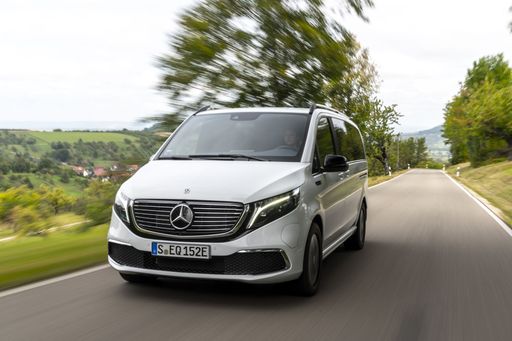 @ group-media.mercedes-benz.com
@ group-media.mercedes-benz.com
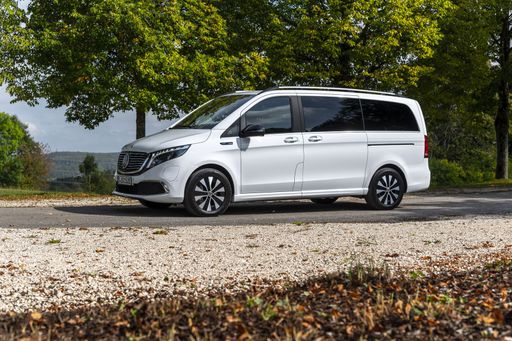 @ group-media.mercedes-benz.com
@ group-media.mercedes-benz.com
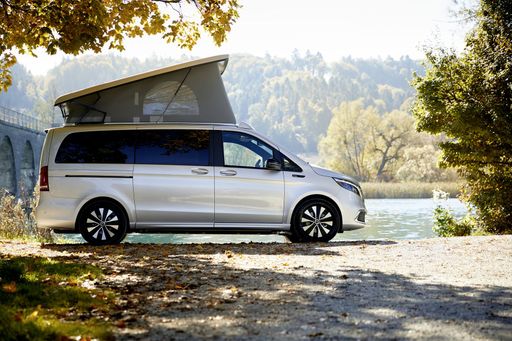 @ group-media.mercedes-benz.com
@ group-media.mercedes-benz.com
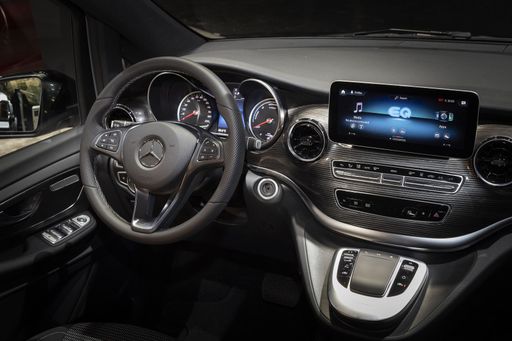 @ group-media.mercedes-benz.com
@ group-media.mercedes-benz.com
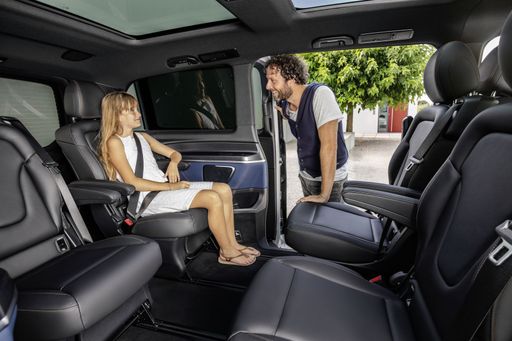 @ group-media.mercedes-benz.com
@ group-media.mercedes-benz.com
Renault Trafic Bus
The Renault Trafic Bus is a versatile and spacious option for those needing to transport multiple passengers comfortably. With its modern design and practical features, it is well-suited for both business and leisure purposes. Its efficient engine and smooth handling make it a reliable choice for long journeys.
details

|
|
|
|
|
Costs and Consumption |
|
|---|---|
|
Price
51300 - 54900 £
|
Price
38200 - 54400 £
|
|
Consumption L/100km
-
|
Consumption L/100km
6.8 - 7.2 L
|
|
Consumption kWh/100km
27.1 - 27.4 kWh
|
Consumption kWh/100km
-
|
|
Electric Range
244 - 365 km
|
Electric Range
-
|
|
Battery Capacity
60 - 90 kWh
|
Battery Capacity
-
|
|
co2
0 g/km
|
co2
179 - 189 g/km
|
|
Fuel tank capacity
-
|
Fuel tank capacity
80 L
|
Dimensions and Body |
|
|---|---|
|
Body Type
Bus
|
Body Type
Bus
|
|
Seats
6
|
Seats
8 - 9
|
|
Doors
5
|
Doors
4
|
|
Curb weight
2666 - 2863 kg
|
Curb weight
2031 - 2352 kg
|
|
Trunk capacity
1030 - 1410 L
|
Trunk capacity
-
|
|
Length
5140 - 5370 mm
|
Length
5080 - 5480 mm
|
|
Width
1928 mm
|
Width
1956 mm
|
|
Height
1920 - 1923 mm
|
Height
1973 - 1974 mm
|
|
Payload
637 - 834 kg
|
Payload
718 - 982 kg
|
Engine and Performance |
|
|---|---|
|
Engine Type
Electric
|
Engine Type
Diesel
|
|
Transmission
Automatic
|
Transmission
Manuel, Automatic
|
|
Transmission Detail
-
|
Transmission Detail
Manual Gearbox, Automatic Gearbox
|
|
Drive Type
Front-Wheel Drive
|
Drive Type
Front-Wheel Drive
|
|
Power HP
204 HP
|
Power HP
110 - 170 HP
|
|
Acceleration 0-100km/h
10.3 - 12.1 s
|
Acceleration 0-100km/h
10.6 - 16.5 s
|
|
Max Speed
140 km/h
|
Max Speed
161 - 180 km/h
|
|
Torque
365 Nm
|
Torque
300 - 380 Nm
|
|
Number of Cylinders
-
|
Number of Cylinders
4
|
|
Power kW
150 kW
|
Power kW
81 - 125 kW
|
|
Engine capacity
-
|
Engine capacity
1997 cm3
|
General |
|
|---|---|
|
Model Year
2024
|
Model Year
2023 - 2025
|
|
CO2 Efficiency Class
A
|
CO2 Efficiency Class
G
|
|
Brand
Mercedes-Benz
|
Brand
Renault
|
Mercedes EQV
Introduction to the Mercedes-Benz EQV
The Mercedes-Benz EQV is the latest addition to the luxury automotive lineup, offering a unique blend of sustainability, performance, and innovative design. This all-electric MPV (multi-purpose vehicle) is designed to cater to the demands of modern family life and business travel, making zero-emission driving a refined and effortless experience.
Performance and Efficiency
At the heart of all EQV models is a robust electric motor producing 204 PS, or 150 kW, which ensures responsive acceleration and a smooth driving experience. With the option of either a 60 kWh or 90 kWh battery capacity, the EQV offers an impressive range of between 244 to 365 kilometres on a single charge, depending on your chosen configuration.
The electric motor's torque of 365 Nm, combined with a state-of-the-art automatic transmission system, ensures seamless gear shifts and optimal energy efficiency. The EQV boasts a consumption of 27.1 to 27.4 kWh per 100 kilometres, making it one of the most efficient vehicles in its class.
Innovative Technology
Mercedes-Benz has equipped the EQV with cutting-edge technology to enhance both driver convenience and passenger comfort. The integrated MBUX (Mercedes-Benz User Experience) system is a highlight, offering voice control and a high-resolution display that keeps drivers connected and informed at all times.
Furthermore, the EQV features advanced driver assistance systems designed to enhance safety and ease of driving. These include Active Brake Assist, Attention Assist, and Crosswind Assist, creating an optimised driving experience regardless of road conditions.
Design and Comfort
The Mercedes-Benz EQV retains the sleek and luxurious design language that is synonymous with the brand. With a length ranging from 5140 to 5370 mm, a width of 1928 mm, and a height of up to 1923 mm, the EQV provides ample space for passengers and luggage, comfortably seating up to six passengers.
The interior is thoughtfully designed with premium materials and flexible seating arrangements, allowing for a rear-seat configuration that suits varied needs, whether for family outings or business commutes. The EQV also offers a spacious boot capacity of 1030 to 1410 litres.
Environmental Impact and CO2 Efficiency
As part of Mercedes-Benz's commitment to sustainability, the EQV has an impressive CO2 efficiency class of 'A'. With zero CO2 emissions during operation, it represents an environmentally-friendly alternative for those seeking luxury without compromise.
Conclusion
The Mercedes-Benz EQV combines luxury, performance, and sustainability, setting a new benchmark for electric vehicles in the MPV segment. Whether for family or business, its advanced technology, thoughtful design, and eco-friendly credentials make it a compelling choice for discerning drivers.
Renault Trafic Bus
A Glimpse into the Renault Trafic Bus: An Icon of Versatility and Innovation
Amongst the plethora of vans designed for both business and leisure, the Renault Trafic Bus stands out as an exemplar of functionality, innovation, and style. Let's delve into what makes the Renault Trafic Bus a popular choice in the UK and across Europe, particularly focusing on its technical specifications and state-of-the-art features.
Performance Dynamics: Power Under the Hood
The Renault Trafic Bus, a staple in Renault's fleet, is driven by a robust diesel engine configuration with power outputs ranging from 110 PS to a formidable 170 PS. The diesel engines combine efficiency and power, offering torque figures between 300 to 380 Nm, ensuring smooth power delivery and capable load hauling.
Drivers can choose between manual and automatic transmissions, both designed to complement the Trafic's front-wheel-drive system. This flexibility ensures that drivers experience enhanced driving comfort whether they are navigating urban roads or cruising on the motorway.
Efficiency Meets Economy
The Trafic Bus showcases impressive fuel economy with consumption figures ranging from 6.8 to 7.2 litres per 100 kilometres. This efficiency is crucial for businesses aiming to minimise operational costs and for families seeking budget-friendly travel options.
With a generous fuel tank capacity of 80 litres, the Renault Trafic Bus is built to cover long distances with fewer fuel stops, making it an ideal choice for long haul journeys.
Technological Innovations and Comfort
The Trafic Bus isn't just about robust performance. Renault has integrated a suite of technological innovations designed to enhance driver and passenger comfort. Its cabins are equipped with the latest infotainment systems and safety technologies, providing an optimal blend of comfort and convenience.
The various trims, such as Life, Start, Spaceclass, and their respective EDC variants, cater to different needs and preferences, ensuring that customers can find the perfect configuration for their requirements.
Design and Dimensions: Space for Every Purpose
Space and versatility are at the heart of the Trafic Bus design. With its dimensions ranging from a length of 5080 to 5480 mm, and a width of 1956 mm, this vehicle offers ample room for passengers and cargo alike. The height stands between 1973 and 1974 mm, ensuring that even taller individuals can travel comfortably.
With seating for up to eight people and a payload capacity between 730 to 1010 kg, the Trafic Bus can transform seamlessly between a people-mover and a goods carrier.
Environmental Considerations
Renault has engineered the Trafic Bus with environmental responsibility in mind. The CO2 emissions range from 178 to 190 g/km, which, while modest for its class, aligns with the efficiency and performance goals set for this versatile vehicle. The CO2 efficiency class is rated as 'G', offering transparency in its environmental impact profile.
Conclusion: A Leader in Its Class
The Renault Trafic Bus continues to lead its segment through a blend of power, efficiency, and technological advancements. Whether it's for commercial transport or family adventures, the Trafic offers a reliable and adaptable solution, setting a high standard for multi-purpose vehicles.
For those seeking a distinguished blend of utility and comfort, the Renault Trafic Bus emerges as an exceptional choice, promising performance and innovation on every journey.
What drivetrain options does the Mercedes EQV have?
The Mercedes EQV is offered with Front-Wheel Drive.
The prices and data displayed are estimates based on German list prices and may vary by country. This information is not legally binding.
